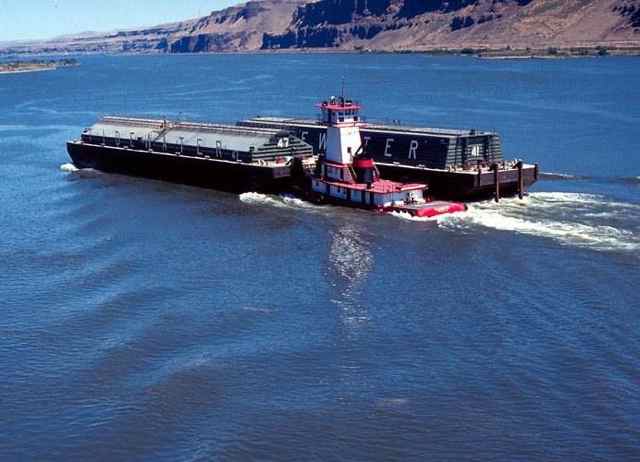forum
library
tutorial
contact

Barging Lets Idaho's Grain Growers
Compete in the World Market
by Stacey Satterlee
Idaho Statesman, December 16, 2017
|
the film forum library tutorial contact |

|
Barging Lets Idaho's Grain Growers
by Stacey Satterlee
|
 I grew up in Eastern Idaho where the Snake River winds its way through the landscape, bringing water and verdant green where it flows. It wasn't until I was in high school that I traveled farther west and viewed with awe the big barges moving down the Snake and Columbia rivers. Now that I represent Idaho's wheat and barley growers, I've learned just how critical those barges are.
I grew up in Eastern Idaho where the Snake River winds its way through the landscape, bringing water and verdant green where it flows. It wasn't until I was in high school that I traveled farther west and viewed with awe the big barges moving down the Snake and Columbia rivers. Now that I represent Idaho's wheat and barley growers, I've learned just how critical those barges are.
In 2016, Idaho was the seventh largest wheat-producing state in the nation, producing 102.8 million bushels of wheat. More than half of Idaho's crop is used domestically and is a main ingredient in pasta, tortillas, bread, cereal, crackers and cookies you and your family likely enjoy. The other half of Idaho's wheat crop is exported, and makes it to those export markets by one of three ways: road, rail or river.
To move approximately 100 million bushels of wheat requires:
(bluefish notes: Rail is the most efficient mode of transportation according to the US Department of Energy. It's basic physics really: rolling a steel wheel on a steel bar vs. spinning propellors in water, choosing the most efficient process is rather elementary. Sending barges up and down locks uses energy that would otherwise generate electricity and barge operators do not pay this cost. Nor do they pay for the operations and maintenance of the locks, the taxpayer pays this bill. It truly is this subsidy that wheat shippers are aiming to protect.)The wheat from North Idaho is going mostly to customers in Pacific Rim countries -- Japan, South Korea and Taiwan. Idaho generally has a very consistent wheat crop, which helps us meet the needs of these customers. But we must also meet their shipping needs to maintain a premium market for our crops; the river transportation system is key to doing that. Grain buyers in Portland can purchase grain in Idaho, have it loaded on a barge in Lewiston, and know to within the hour when it will arrive to be sorted and loaded on a vessel. A small amount of wheat can be sourced in Portland by semi-truck out of the Willamette Valley, and some unit trains of wheat are railed in. But having three modes of transportation provides competition and flexibility that helps us trade in the world wheat market.
One grower in Genesee estimates that it is 36.5 cents per bushel cheaper to truck and barge his wheat to Portland than it is to use truck and rail. With his average yields, that would equate to over $30 an acre more in transportation costs to truck his wheat to the closest unit train facility and get it to the port of Portland by rail than it is to truck it to Lewiston and barge it down the river. To say that taking away the river transportation system would be costly and disruptive is a vast understatement.
The good news for everyone concerned with dams and the survival of salmon is that salmon recovery efforts are working. Since 1978, the Northwest has spent over $14 billion on increasing salmon runs. Improvements at the dams, such as turbine upgrades, mechanical bypass systems and fish ladders, help salmon safely travel down the river and back up to spawn as adults.
And as a result, fish runs on the Snake River have seen record returns in recent years. In 2014, salmon returned to the Columbia River Basin in the highest numbers in over 75 years. Between 2002 and 2011, average wild Chinook salmon populations more than tripled, and average wild steelhead populations doubled.
So, on the question of where we go from here -- in Judge Simon's recent decision, the Action Agencies have been instructed to issue an Environmental Impact Statement (EIS) and to consider dam breaching as an option. This process has to play out between now and 2021, when the EIS is completed. But we think there's a strong case for the dams, and for salmon and dams coexisting.
Idaho's grain growers will also continue to support the Nez Perce Water Rights Agreement and the limits that it places on flow augmentation from Idaho's irrigation reservoirs. Those continued water supplies are critical for agriculture.
Idaho's grain producers urge the Trump administration to continue investing in the locks and dams on the Snake and Columbia rivers. We recommend staying the course on salmon recovery efforts, continuing to get affordable and clean energy via hydropower generation at the dams, and continuing water storage to prevent flooding and to irrigate our crops so that we can feed ourselves, our neighbors and the world. We also support continued fishing, waterskiing and recreation on the water with our families at the reservoirs the dams provide. And of course, we support barge transportation on the river.
learn more on topics covered in the film
see the video
read the script
learn the songs
discussion forum
